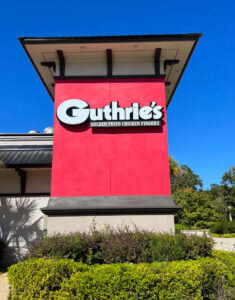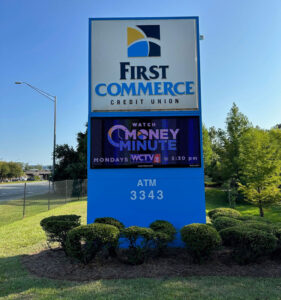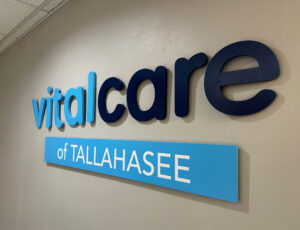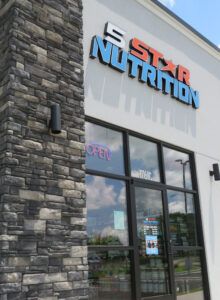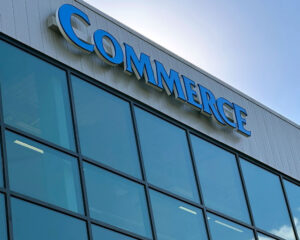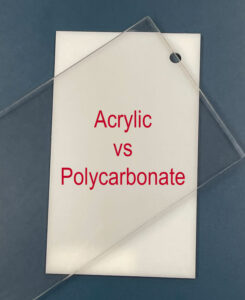
When choosing between acrylic and polycarbonate in the sign industry, understanding the differences between these two materials is essential for selecting the right one for your project. Both are versatile and transparent plastics commonly used in signs, but they serve different purposes due to variations in strength, clarity, cost, and workability. The following comparison will guide you in determining which material is best suited for different types of signage, whether you’re designing storefront signs, outdoor displays, or protective covers.
Key Differences Between Acrylic and Polycarbonate in Signage
Durability and Strength
- Acrylic is strong but less impact-resistant than polycarbonate. It’s a great option for indoor signs, displays, and aesthetic elements where durability isn’t the highest priority. It offers enough rigidity for standard signage but may crack if exposed to extreme forces.
- Polycarbonate, on the other hand, is incredibly durable and virtually unbreakable. For signs in high-traffic areas, harsh environments, or places prone to vandalism, polycarbonate offers the best protection. It’s ideal for large outdoor signs, illuminated signage, and safety applications.
Clarity and Aesthetic
- Acrylic offers excellent clarity with a glass-like shine, making it the go-to material for signs that need to catch attention, such as lobby signs, point-of-purchase displays, and high-end storefront signs. Its visual appeal and clarity hold up well over time, without yellowing under UV exposure.
- Polycarbonate also provides high clarity but is less glossy than acrylic and may turn yellow without UV protection. While less aesthetically shiny, it’s better suited for signs that need to withstand severe weather or impact. Protective coverings for illuminated signs or outdoor LED displays often benefit from polycarbonate’s toughness.
Workability
- Acrylic is easier to cut, shape, and polish, making it a preferred material for custom-shaped signs, intricate designs, and detailed work, especially for interior applications. However, its brittleness means it can crack if not handled carefully during fabrication.
- Polycarbonate, being tougher, is more challenging to work with but less prone to cracking. For large-scale outdoor signs like pylon signs or electronic message centers, polycarbonate offers enhanced strength, although it requires specialized equipment for cutting and shaping.
Cost
- Acrylic is generally more affordable, making it a cost-effective choice for small businesses or budget-conscious projects. It’s perfect for decorative indoor signs, plaques, or menu boards where high impact resistance isn’t necessary.
- Polycarbonate is more expensive due to its superior durability. In high-risk environments, the additional cost can provide better long-term value by reducing the need for frequent replacements or repairs. Outdoor signage, security signs, or signs exposed to heavy wear benefit most from polycarbonate’s resilience.
Chemical and Weather Resistance
- Acrylic offers good weather resistance, especially for outdoor signs, but it can be damaged by certain chemicals. Its resistance to UV rays makes it ideal for signs that will be exposed to sunlight for long periods.
- Polycarbonate has better chemical and impact resistance, making it a better fit for industrial signage and areas exposed to harsh environments or potential vandalism. With proper UV protection, polycarbonate signs can last longer in outdoor conditions without yellowing or cracking.
Applications in the Sign Industry
- Acrylic is ideal for indoor signage, menu boards, window signs, display cases, and decorative signage where aesthetics and clarity are crucial. Its glass-like look elevates branding for companies looking for professional, clean, and eye-catching signage.
- Polycarbonate is the material of choice for outdoor signs, illuminated signs, electronic message centers, security shields for digital displays, and industrial signage. Its toughness and impact resistance ensure longevity in rough environments.
Comparison Chart
| Feature | Acrylic | Polycarbonate |
| Strength | Suitable for light-duty signs, may crack | Extremely durable and impact-resistant, ideal for high-stress environments |
| Clarity | Excellent clarity and shine, doesn’t yellow | Clear but less glossy, can yellow without UV protection |
| Workability | Easy to cut, shape, and polish, brittle | Tougher to work with, but less prone to cracking |
| Cost | More affordable, good for budget-friendly projects | More expensive, but better long-term value for high-impact signage |
| Chemical Resistance | Lower chemical resistance, may be damaged by solvents | High resistance to chemicals, ideal for industrial signage |
| Weather Resistance | Good UV protection, excellent for outdoor use | May need UV coating, withstands extreme conditions |
| Applications | Indoor displays, lobby signs, custom decorative signs | Outdoor signs, electronic message centers, security signage |
Summary
In the sign industry, the choice between acrylic and polycarbonate comes down to the specific needs of the project.
Acrylic is the better option for signage where aesthetics, clarity, and cost are the main concerns, such as indoor and storefront signs. Its smooth, glossy finish makes it visually appealing, and its ease of fabrication allows for creative designs.
Polycarbonate, on the other hand, is the best choice for outdoor signs, high-impact areas, and environments where durability is critical. Though it comes at a higher cost, polycarbonate’s toughness and resistance to extreme conditions make it the material of choice for long-lasting, heavy-duty signage.
By understanding these differences, you can select the material that aligns with the environmental, aesthetic, and budgetary demands of your signage projects, ensuring that your signs are both functional and visually appealing for the long term.

